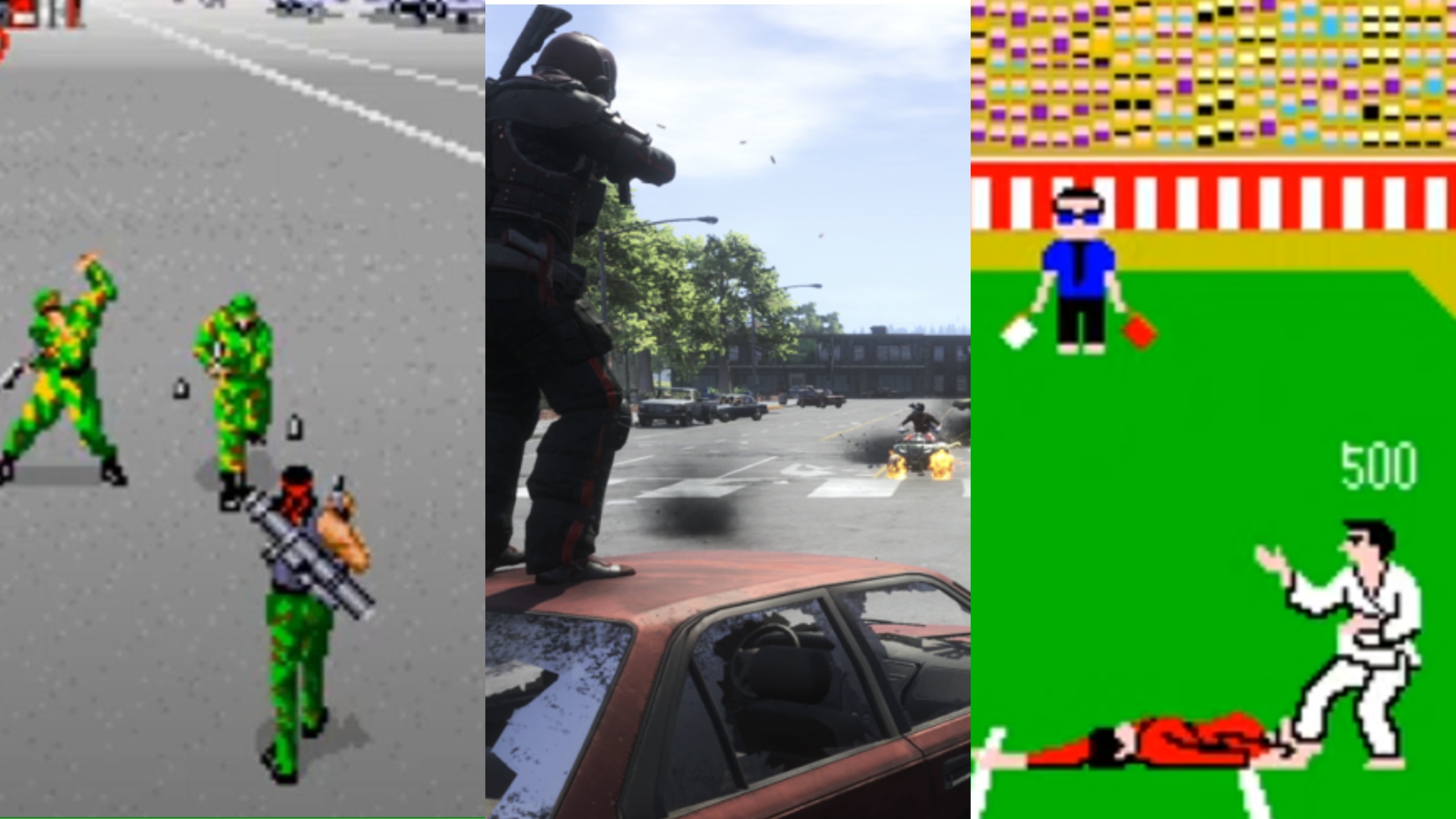
Though it’s easy to get caught up in fruitless debates over genre classifications, genres are a fascinating part of any medium’s evolution. Yes, they sometimes oversimplify complex works for the purposes of classification. However, a deeper look at the origins of those genres often reveals fascinating facts about the evolution of art and entertainment.
That’s especially true of gaming. Many of us have been alive for most of the notable history of video games. Yet, it’s still remarkably easy to forget how some of the more unique and prevalent video game genres actually began.
Today, we’re going to take a look at the birth of some of those genres. Some were clearly created by the release of a revolutionary new title, while others can trace their origins to games that took an existing concept in a new direction. Some are world-famous, while others have been forgotten and never really got the full credit they deserved. However it happened, these are the games that helped create entire genres.
Battle Royale – H1Z1: King of the Kill
Technically, variations of the “Last Man Standing” game mode have existed for decades. If we’re talking about games that exemplify the post-Koushun Takami Battle Royale idea of that concept, though, then you have to look at Minecraft’s Survival Games mod or Arma III’s DayZ mod to see the foundations of what we now consider a battle royale experience. However, those games didn’t really feature the proper proportions of battle royale concepts and were actually closer to what we now consider to be the “Survival” genre in many ways.
So far as that goes, 2015’s H1Z1: King of the Kill should be considered the first proper Battle Royale gaming experience. That mode utilized the survival mechanics of titles like DayZ, but converted them into a more match-based multiplayer contest that revealed the Battle Royale’s potential as an evolution of the classic Deathmatch/Last Man Standing concept. H1Z1 directly paved the way for PUBG, which inspired Fortnite, which really turned Batte Royales into blockbusters.
Beat-Em-Up – Kung-Fu Master
While there were many early games that emphasized some kind of combat-based gameplay, the Beat-Em-Up is a genre unto itself. These titles made the action the star of the show by pitting you against seemingly endless waves of opponents with limited means to defend yourself (your fists, usually, with weapons and powers later becoming more common). Though later Beat-Em-Up games would expand upon that concept in various ways (including the addition of light role-playing mechanics), the roots of the genre have remained surprisingly strong over the years.
Well, you can trace those roots back to 1984’s Kung-Fu Master. Inspired by the martial arts films of Bruce Lee, that game utilized a then-distinct form of side-scrolling action that saw players work their way through a temple by punching and kicking every foe in their path. It’s actually quite remarkable to play this game today and see just how clearly it envisioned a genre that remains noteworthy for its timeless, simple pleasures.
Fighting Games – Karate Champ
Unlike Beat-Em-Up games that pit players against a small army of opponents, Fighting games have historically emphasized the joys of one-on-one combat (though later Fighting games would certainly expand those numbers). The challenge of such games wasn’t found in their seemingly insurmountable odds but rather in the art of taking on an equally capable opponent (especially if that opponent is controlled by another player).
The origins of that genre are subject to some debate. Technically, 1976’s Heavyweight Champ would have to be considered the first game that let players battle each other one-on-one in a fighting environment. However, that game only vaguely resembles a true fighting title. Instead, it was 1984’s Karate Champ that first showcased the potential of future fighting games with its style of on-on-one combat. Though it lacked things like health bars, Karate Champ featured multiple rounds of play, input-based special moves, and even minigames. Of course, it was Street Fighter 2 that eventually established even more of the fighting game conventions we know and love today.
First-Person Shooters – Maze War
1993’s Doom ushered in a new age of First-Person Shooter titles that we’re really still living in today. That game’s 3D technology, dark style, and innovative multiplayer changed the ways that studios, gamers, and the media looked at the entire medium. For some time, most FPS games were simply referred to as “Doom Clones.” However, the first-person shooter genre is much older than that.
1973’s Maze War actually laid out a pretty clear blueprint for what first-person shooter games would become. That wire-frame title even let players compete against each other over (obviously limited) video game networks. It also featured optional bot opponents, the ability to peek around corners, and other concepts that wouldn’t become “standard” until decades later. Had Maze War been more widely available a decade or 15 years after its release, it would have almost certainly generated a Doom-like stir.
Massively Multiplayer Online Role Playing Games – Island of Kesmai
1991’s Neverwinter Nights (no, not that Neverwinter Nights) is often cited as the first true MMORPG, and I can see why. That game allowed players to easily share a visually rich (relative to its time) fantasy world. It even introduced or refined now-common MMORPG social concepts like guilds. It is, at the very least, a shockingly early example of an advanced concept. Every MMORPG that followed built upon it in some way.
However, I’m giving the nod to 1985’s Island of Kesmai. Why? Well, despite its painfully simple ASCII graphics (think Rogue) and obviously limited network, it still allowed up to 100 players to share a fantasy world filled with monsters, loot, quests, classes, and most of the other major things you’d associate with an MMORPG. The game even supported what we would now consider to be MMORPG expansion packs.
MOBAs – Defense of the Ancients
Essentially a hybrid of real-time strategy titles and more hero-based multiplayer titles, the Multiplayer Online Battle Arena (MOBA) genre has become one of the most popular and influential genres of the last 20 years. Though there are numerous differences between the biggest MOBA games out there, they generally see players pick “hero” characters and then work together to take over lane-based territories controlled by NPCs before the opposing team can do the same. MOBAs League of Legends are globally famous for their lucrative competitive scenes, demanding gameplay, and, more often than not, toxically intense communities.
Tracking the origins of this genre is a fascinating exercise in interpretation. For instance, 1998’s Future Cop: LAPD actually included a special multiplayer mode that is shockingly similar to the modern MOBA format. StarCraft’s Aeon of Strife map later refined that concept by incorporating many concepts that later became standard in MOBA titles (such as using currency to purchase upgrades).
Even still, I think this honor belongs to the Defense of the Ancients mod for Warcraft III. That game not only introduced most of the core components that now clearly distinguish MOBA titles (most notably, PvP play) but also helped the emerging subgenre explode in popularity. This is a case where a number of obvious refinements introduced in a short period of time ultimately mean more than technical firsts.
Platformers – Donkey Kong
They may be one of the most important video game genres ever, but properly defining a Platformer game is often a tricky task that makes the process of identifying the first Platformer that much more difficult.
It is, however, generally agreed that a Platformer is built around the player’s ability to maneuver a character between set points in an environment in order to complete objectives or levels. Unlike early maze games like Pac-Man, platformers allowed for greater freedom of movement that emphasizes a player’s ability to both dynamically react to incoming dangers and consider various pathing options.
That’s why I have to go with the more popular opinion and give this honor to 1981’s Donkey Kong. While some argue that 1980’s Space Panic is actually an earlier example of this genre, I would say that the game’s lack of a “jump” ability makes it feel closer to a reimagined version of that aforementioned maze-like experience. The ability to jump in Donkey Kong (and the ways the game demanded you to reflexively use that ability while navigating a platform-based environment) set us up for the definitive platformers that would come later in the decade. Still, this is an interesting example of a genre evolving over time and our definitions of that genres evolved alongside it.
Puzzle Games – Loco-Motion
The Puzzle genre is another one of those gaming genres that will seemingly always be with us. From tile-based puzzle games to more advanced 3D narrative-based titles (like The Witness or Portal), some kind of Puzzle game will always find an audience. That’s to say nothing of the countless games that feature puzzles as a core piece of their overall experience.
That distinction is incredibly important in this instance. When we’re talking about the first puzzle game ever, we’re really talking about the first game that made the act of solving a puzzle the primary mechanic. So far as that goes, there were a few games released around the same time (early ’80s) that really experimented with the concept of solving a puzzle as the primary form of entertainment.
However, my vote goes to Konami’s 1982 game, Loco-Motion. This sliding block puzzle title that saw you create new tracks for a constantly moving train really “gamified” the traditional puzzle concept in ways that we hadn’t seen before. Actually, there’s an almost Crazy Taxi-like logic to this game’s point and time limit systems that makes it surprisingly enjoyable to play today. Of course, Tetris was the biggest game-changer of this particular genre.
Real-Time Strategy – Utopia
This is another case where defining a genre becomes a crucial (but complicated) part of this discussion. What I’m really looking for, though, is a game that takes the strategic concepts of something like Risk or Stratego yet allows you to compete against another player (or a computer opponent) in real-time rather than across numerous turns. The more that game emphasizes elements of what later became definitive RTS experiences (specifically base-building, combat, and resource gathering), the better.
Ultimately, most roads lead back to 1982’s Utopia. Utopia’s island settling gameplay is much closer to something like Civilization than Command and Conquer, but the real-time speed of this title was a true game-changer, as were the ways this title turned resource management and gathering into competitive pursuits. There was even a minor combat element to this experience.
The concept of real-time competitive strategy would only evolve from here thanks to revolutionary ’80s titles like Herzog Zwei. However, it was 1992’s Dune 2 that pretty much established the modern RTS formula overnight (and also first utilized and popularized that genre term).
Rhythm Games – Dance Aerobics
While Rhythm games are nowhere near as popular as they were in the 2000s, titles like Guitar Hero, Dance Dance Revolution, and even PaRappa the Rapper will always hold a special place in many hearts. We even still see the basic rhythm game concept (timing inputs to some kind of musical beat) pop up as a mechanic or minigame in many modern titles.
While the aforementioned PaRappa the Rapper was almost certainly the first rhythm game most people actually played 1987’s Dance Aerobics has to be considered the first true rhythm game. This relatively forgotten title asked players to use the Power Pad peripheral to match the moves of an on-screen dance instructor. Yes, it was essentially an early version of DDR (though not nearly as refined or, you know, fun).
Open-World Games – Elite
The surest way to get gaming historians to argue is to bring up the topic of the first “open-world” game. See, by definition, an open-world game is a game that allows players to freely explore a given space without the typical restrictions seen in other titles (such as pre-determined levels, cutoff objectives, and various other literal and metaphorical walls). However, that definition could apply to something like 1980s Adventure or even text-based adventure titles. Early CRPGs also offered overworld areas that could be explored with relative freedom.
However, it’s hard to look at many of those games and see what we now consider to be an open-world title. That’s why I think this honor has to go to 1984’s Elite.
Elite‘s revolutionary gameplay allowed people to live out their sci-fi fantasies by participating in various activities spread throughout a universe of explorable locations. Though visually simple and obviously limited by the numerous technical restrictions of its time, Elite utilized the idea of untamed explortion and discovery in ways that earlier pseudo-open worlds did not. I also have to give a shout-out to 1985’s Mercenary: the game that was pretty much Grand Theft Auto before GTA.
Survival Horror – AX-2: Uchū Yusōsen Nostromo
Developers have been experimenting with horror themes in games since gaming’s earliest days. However, technological limitations and various cultural factors ensured that genuinely scary, true “horror” games didn’t become slightly more common until the late ‘80s and early ‘90s. Even then, it wasn’t until 1996’s Resident Evil that the core ideas of Survival Horror (an intense style of horror gaming based on resource management, terrifyingly powerful enemies, and a general feeling of helplessness) really started to take off.
However, the Survival Horror genre is much older than that. Though there are numerous horror games released before Resident Evil that never get enough love, 1981’s AX-2: Uchū Yusōsen Nostromo is the earliest and most obvious example of a true Survival Horror title. Inspired by the movie Alien, AX-2: Uchū Yusōsen Nostromo tasked you with wandering the halls of a spaceship in order to acquire the resources needed to escape a deadly alien creature that is constantly hunting you. While it may have gone largely unnoticed in its day, you can’t look at that game’s use of puzzles, inventory, and a stalker creature and not see what Survival Horror games eventually became.
Stealth – Shoplifting Boy
The entire point of the Stealth genre is also the thing that has often prevented the genre from being more popular over the years. Simply put, it takes a certain type of gamer to really enjoy the often demanding process of sticking to the shadows rather than simply shooting your way through obstacles. Yet, it is that emphasis on sneaking and avoidance that ultimately defines the Stealth genre.
Once again, tracing the origins of this genre is tricky. The Guinness Book of World Records seems to believe that the 1981 Sega title 005 is the first true stealth game, but that’s a highly debatable claim. Not only did the legendary Castle Wolfenstein come out earlier that same year, but Taito’s 1980 arcade game Lupin the 3rd utilized an undeniable stealth-based format before either game.
However, I have to give the nod to Hiroshi Suzuki’s 1979 game, Shoplifting Boy. That innovative title saw you play as a kid trying to shoplift items from a store without being caught by the roaming attendant. While the distribution of that game was a little wonky and somewhat mysterious, it is the official inspiration for Lupin the 3rd, which ultimately makes it historically noteworthy.
Text Adventure – Colossal Cave Adventure
1977’s Zork certainly popularized the concept of a text-based adventure game and briefly made that genre one of the early definitive PC gaming experiences. However, developers started playing with the concept of such adventure games long before that. You can go way back to the 1960s and find examples of people playing with games that were essentially digital versions of choose-your-own-adventure games.
However, 1976’s Colossal Cave Adventure has to be considered the undisputed godfather of this genre. Zork refined and expanded upon many of this game’s ideas, but all the hallmarks of the text adventure genre are found in Colossal Cave Adventure. It was a groundbreaking achievement in the relationship between narrative and interactivity that eventually led to some of the greatest games ever made.
Third-Person Shooter – Devastators/Fade to Black
While we’ve been shooting enemies in 2D games since the 1970s, the third-person shooter is really its own beast. A cousin to the first-person shooter, third-person shooters are 3D action titles that put the player behind the protagonist rather than allowing them to view the game through their eyes, from the side, or via a top-down point-of-view.
It’s that perspective that proves to be a crucial qualifier when identifying the origins of this genre. Ultimately, I have to split this category between two noteworthy titles: 1988’s Devastators and 1995’s Fade to Black. Devastators was basically Konami’s attempt to turn the third-person shooting segments from Contra into their own game. It laid the foundation for more advanced third-person shooters to come (and even included a rudimentary cover system). However, if you believe that a true third-person shooter must be a 3D game, then Fade to Black is probably the title you’re looking for. That game utilized the kind of dynamic third-person shooting (and camera system) that would become much more popular in the years that followed.
The post 15 Games That Invented New Genres appeared first on Den of Geek.









